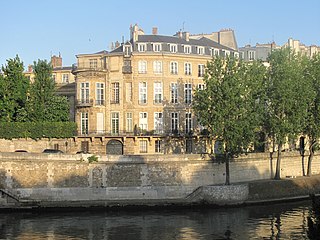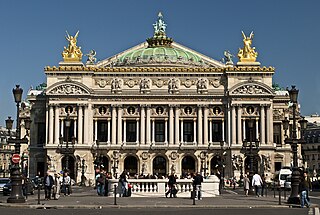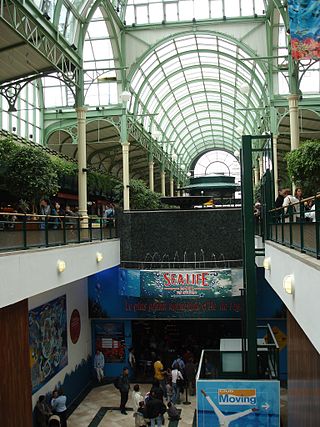
The Paris Métro, operated by the Régie autonome des transports parisiens (RATP), is a rapid transit system in the Paris metropolitan area, France. A symbol of the city, it is known for its density within the capital's territorial limits, uniform architecture and unique historical entrances influenced by Art Nouveau. The system is 226.9 kilometres (141.0 mi) long, mostly underground. It has 308 stations of which 64 have transfers between lines. There are 16 lines, numbered 1 to 14, with two lines, 3bis and 7bis, named because they started out as branches of Line 3 and Line 7, respectively. Line 1, Line 4 and Line 14 are automated. Lines are identified on maps by number and colour, with the direction of travel indicated by the terminus.

The Réseau Express Régional, commonly abbreviated RER, is a hybrid commuter rail and rapid transit system serving Paris and its suburbs. It acts as a combined city-center underground rail system and suburbs-to-city-center commuter rail. In the city center, it acts as a faster counterpart of the Paris Métro, having fewer stops.

A metro station or subway station is a train station for a rapid transit system, which as a whole is usually called a "metro" or "subway". A station provides a means for passengers to purchase tickets, board trains, and evacuate the system in the case of an emergency. In the United Kingdom, they are known as underground stations, most commonly used in reference to the London Underground.

Châtelet is a station of the Paris Métro and Île-de-France's RER commuter rail service, located in the centre of medieval Paris, on the border between the 1st and 4th arrondissements. It serves RER A, RER B and RER D, as well as Line 1, Line 4, Line 7, Line 11 and Line 14 of the Paris Métro; it is the southern terminus of Line 11. The station is made up of two parts connected by a long corridor: Lines 7 and 11 under the Place du Châtelet and the Quai de Gesvre, next to the Seine; Lines 1, 4 and 14 towards Rue Saint-Denis and the Rue de Rivoli.

Les Halles is a station on Line 4 of the Paris Métro. Located in the 1st arrondissement, it takes its name from the market halls which were on the site for many years.

The Gare de l'Est, officially Paris Est, is one of the seven large mainline railway station termini in Paris, France. It is located in the 10th arrondissement, not far southeast from the Gare du Nord, facing the Boulevard de Strasbourg, part of the north–south axis of Paris created by Georges-Eugène Haussmann.

Gare d'Orsay is a former Paris railway station and hotel, built in 1900 to designs by Victor Laloux, Lucien Magne and Émile Bénard; it served as a terminus for the Chemin de Fer de Paris à Orléans. It was the first electrified urban terminal station in the world, opened 28 May 1900, in time for the 1900 Exposition Universelle. After closure as a station, it reopened in December 1986 as the Musée d'Orsay, an art museum. The museum is currently served by the RER station of the same name.

Paris Métro Line 14 is one of the sixteen lines on the Paris Métro. It connects the stations Mairie de Saint-Ouen and Olympiades on a north-west south-east diagonal via the three major stations of Gare Saint-Lazare, The Châtelet–Les-Halles complex and the Gare de Lyon. The line goes through the centre of Paris, and reaches the communes of Saint-Ouen-sur-Seine and Clichy.

The Hôtel Lambert is an hôtel particulier, a grand mansion townhouse, on the Quai Anjou on the eastern tip of the Île Saint-Louis, in the 4th arrondissement of Paris. In the 19th century, the name Hôtel Lambert also came to designate a political faction of Polish exiles associated with Prince Adam Jerzy Czartoryski, who had purchased the Hôtel Lambert.

Victor Baltard was a French architect famed for work in Paris including designing Les Halles market and the Saint-Augustin church.

Châtelet–Les Halles station is a major train hub in Paris and one of the largest underground stations in the world. Opened in 1977, it is the central transit hub for the Paris metropolitan area, connecting three of five RER commuter-rail lines and five of sixteen Métro lines. The hub hosts 750,000 travellers per weekday and platforms separated by up to 800 metres (0.5 mi). It is named after the nearby Place du Châtelet public square and Les Halles, the former wholesale food market of Paris, now a shopping mall.
Historical quarters of Paris are areas of Paris, France that have retained an older character, usually identifiable by commercial or cultural activity and often named for a neighborhood landmark. These sections often are not referenced on modern-day maps of Paris, crossing current arrondissements.

RER B is one of the five lines in the Réseau Express Régional, a hybrid commuter rail and rapid transit system serving Paris, France and its Île-de-France suburbs. The 80-kilometre (50 mi) RER B line crosses the region from north to south, with all trains serving a group of stations in central Paris, before branching out towards the ends of the line.

RER D is one of the five lines in the Réseau Express Régional, a hybrid commuter rail and rapid transit system serving Paris and its suburbs. The 190-kilometre (120 mi) line crosses the region from north to south, with all trains serving a group of stations in central Paris, before branching out towards the ends of the line.

Line 4 is one of the sixteen lines of the Paris Métro rapid transit system and one of its three fully automated lines. Situated mostly within the boundaries of the City of Paris, it connects Porte de Clignancourt in the north and Bagneux-Lucie Aubrac in the south, travelling across the heart of the city. Until its southern terminus was changed from Porte d'Orléans to Mairie de Montrouge in 2013, the line was sometimes referred to as the Clignancourt – Orléans Line. At 13.9 km (8.6 mi) in length, it connects with all Paris Métro lines apart from the very short 3bis and 7bis branch lines, as well as with all 5 RER express lines. It also serves three of the Paris Railway stations, Gare du Nord, Gare de l'Est, and Gare Montparnasse. It is the second-busiest Métro line after Line 1, carrying over 154 million passengers in 2004.
Paris Métro Line 11 is one of the sixteen lines of the Paris Métro. It links Châtelet to Mairie des Lilas in the northeastern suburbs. At a length of 6.3 km and 13 stations served, it is currently the shortest of the 14 main Métro lines but is being extended by 6 stations. With 47.1 million riders in 2017, it is the thirteenth busiest line in the network.

The Church of St. Eustache, Paris, is a church in the 1st arrondissement of Paris. The present building was built between 1532 and 1632.

Chambourcy is a commune in the Yvelines department in the Île-de-France region in north-central France. It is located 3 km (1.9 mi) west of Saint-Germain-en-Laye and about 25 km (16 mi) west of Paris.

Second Empire style, also known as the Napoleon III style, is a highly eclectic style of architecture and decorative arts, which uses elements of many different historical styles, and also made innovative use of modern materials, such as iron frameworks and glass skylights. It flourished in the Second French Empire during the reign of Emperor Napoleon III (1852–1870) and had an important influence on architecture and decoration in the rest of Europe and North America. Major examples of the style include the Opéra Garnier (1862–1871) in Paris by Charles Garnier, the Bibliothèque nationale de France, the Church of Saint Augustine (1860–1871), and the Philadelphia City Hall (1871–1901). The architectural style was closely connected with Haussmann's renovation of Paris carried out during the Second Empire; the new buildings, such as the Opéra, were intended as the focal points of the new boulevards.

Val d’Europe is a shopping mall located 30 minutes to the east of Paris, the French capital and 5 minutes from the Disneyland Paris theme park and the Villages Nature holiday village.























